Doberman Pinscher Dog Breed
The Doberman Pinscher stands out with its regal posture and sleek profile, balancing beauty and intimidation. This breed was first bred in Germany in the late 1800s. It was designed for aesthetics and performance, showcasing smarts, power, and quickness. Initially serving as guard dogs and in law enforcement, Dobermans have adapted to become multifaceted pets, thriving in various roles.
However, there’s more to these dogs than meets the eye. Anyone considering a Doberman should thoroughly understand their personality, health needs, and living requirements. It’s a commitment that involves learning about what makes these dogs tick. As we think about their role in modern homes and society, we see that caring for these noble dogs requires thoughtful consideration.
Dobermans are known for their loyalty and can be affectionate with their families. They often require a lot of exercise and mental stimulation to stay healthy and happy. Training is essential for Dobermans, as it channels their energy and intelligence in a positive direction. Health-wise, they can be prone to certain conditions like heart issues and hip dysplasia, so regular vet check-ups are crucial.
When living with a Doberman, providing a loving home that understands the breed’s needs is essential. Their future as beloved pets depends on responsible ownership that respects their complex nature.
Key Takeaways
- Dobermans excel as loyal and versatile companions.
- Regular exercise and mental challenges keep them content.
- Consistent Doberman Pinscher and health checks are vital.
The Doberman Pinscher, a breed with a noble stance and streamlined shape, originated in Germany around the end of the 19th century. Initially bred for their impressive looks and agility, these dogs have become versatile, serving various roles beyond security.
Understanding a Doberman goes beyond their appearance. Prospective owners must grasp their temperament, health needs, and lifestyle demands to ensure these canines flourish.
These dogs bond deeply with their families and need ample physical activity and brain engagement. They’re susceptible to health issues like cardiac problems and joint dysplasia, making routine veterinary visits indispensable.
A Doberman’s well-being hinges on a nurturing environment that caters to its specific requirements, underpinning its continued presence as a cherished household pet.
Quick Facts
The Doberman Pinscher is known for its intelligence and strong sense of loyalty. They stand between 24 and 28 inches tall and weigh between 60 and 100 pounds. The AKC ranks them as the 15th most popular dog breed. As a member of the Working Group, Dobermans usually live for about 10 to 12 years. They were initially bred from the German Pinscher and are recognized for their athletic physique, which made them excellent in security and police work.
Dobermans need to start training and socializing early to manage their protective instincts. When choosing a Doberman, it’s better to adopt from rescue organizations or responsible breeders who prioritize the breed’s health and behavior. They can adapt to living in an apartment with enough exercise and mental stimulation. Dobermans are low maintenance in grooming, which is excellent for active owners dedicated to their dog’s care and well-being.
Doberman Pinscher Dog Breed Pictures
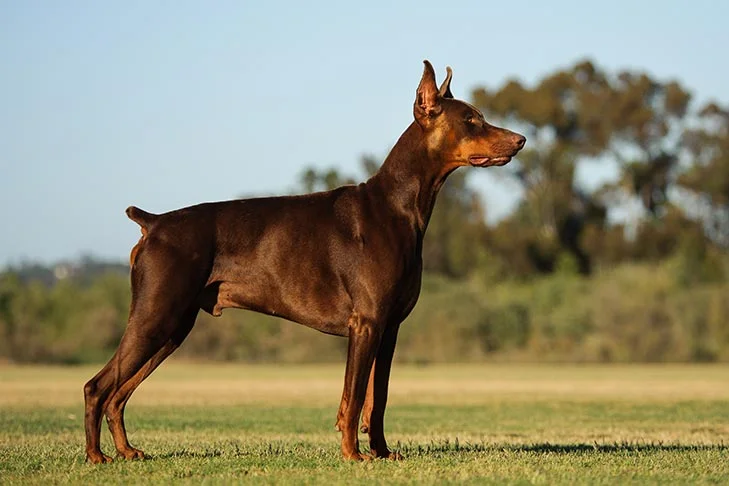
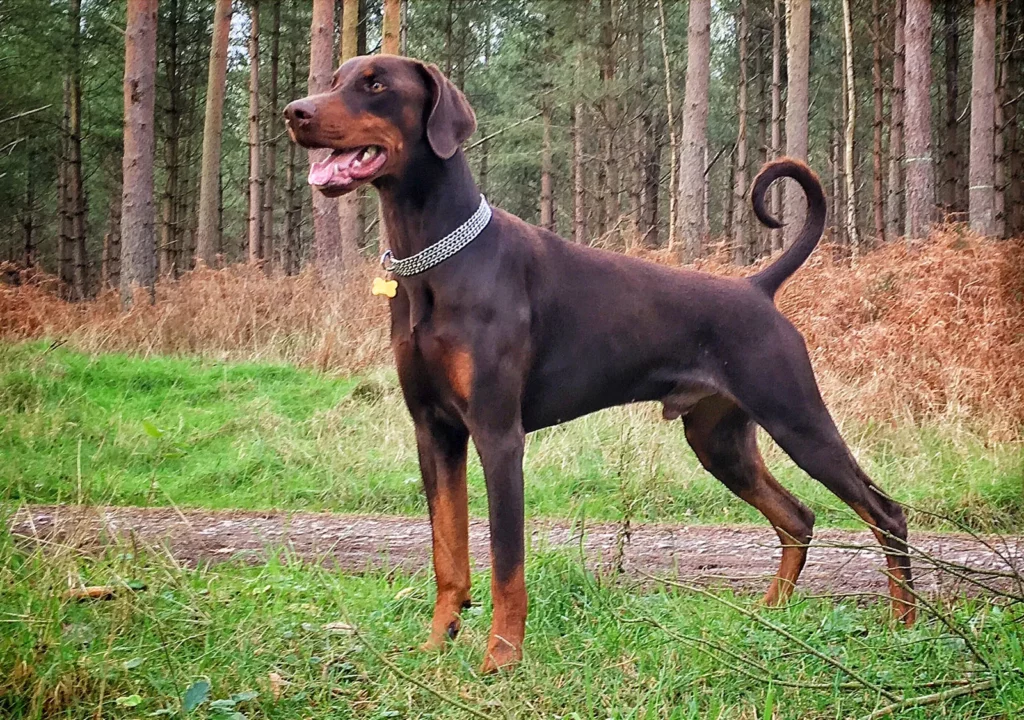
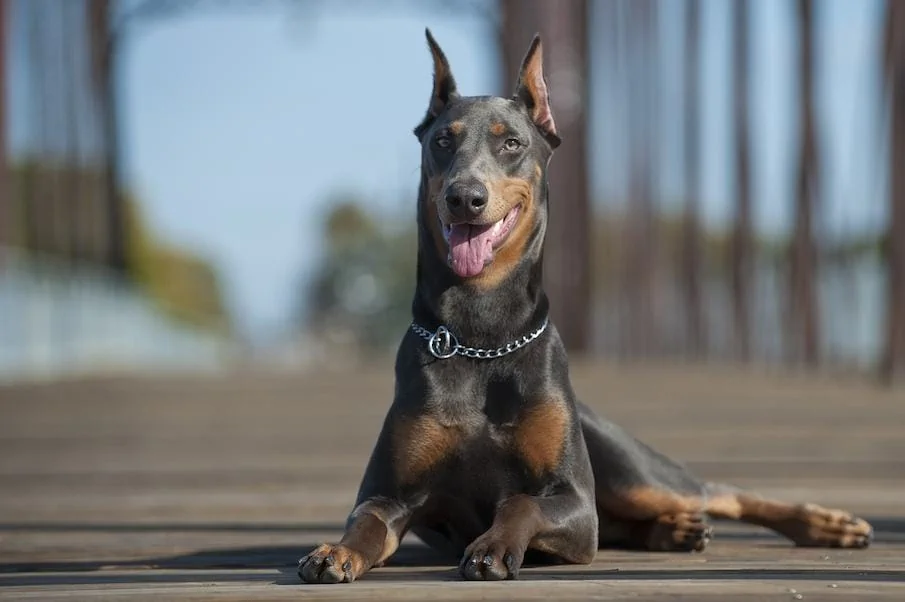
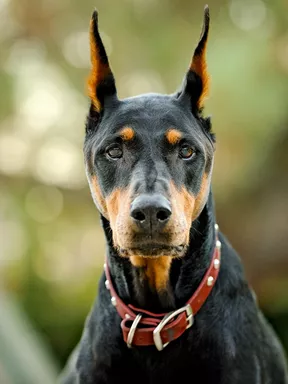
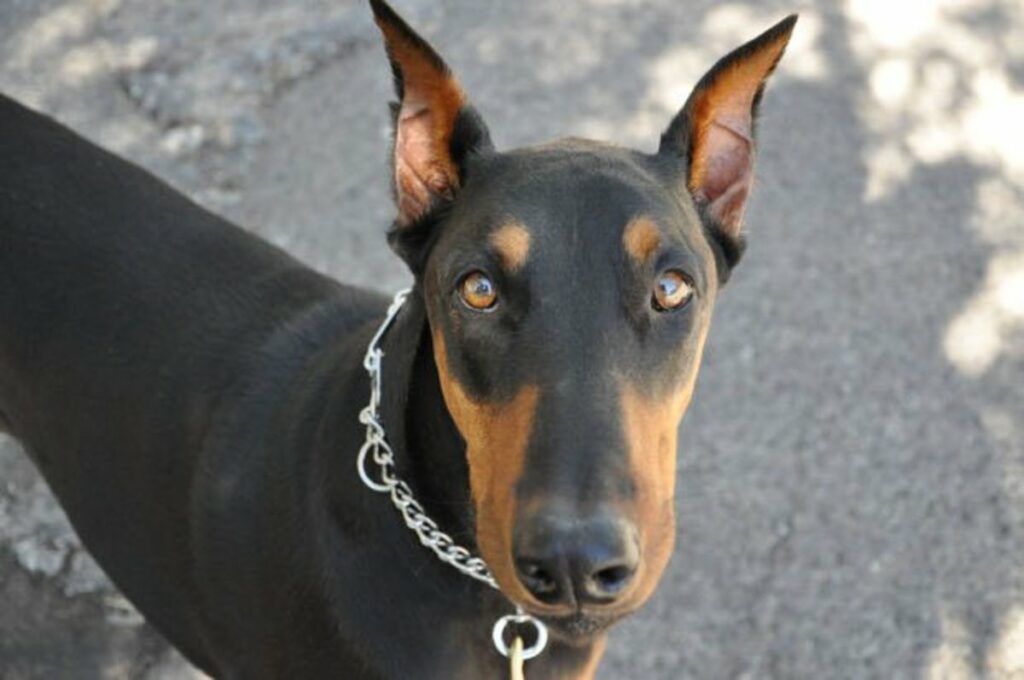
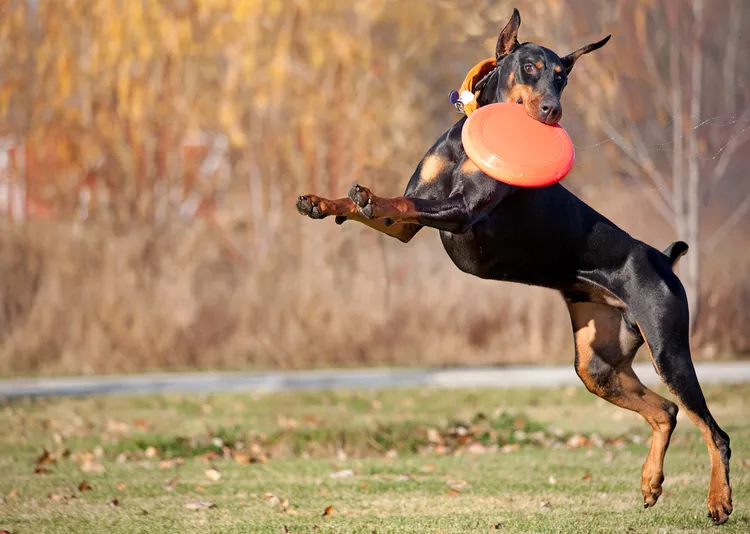
Doberman Pinschers Overview
Doberman Pinschers from Germany are known for their strong heritage as working dogs. This is evident in their sharp intelligence, deep loyalty, and natural protective instincts. These dogs typically enjoy a life expectancy of 10 to 13 years and have sleek coats that can be black, red, blue, or fawn, each paired with distinct rust-colored markings.
Training a Doberman is usually a smooth process thanks to their smarts and desire to make their owners happy. However, this requires regular and encouraging training sessions to maximize their abilities.
Doberman Pinschers naturally tend to be vigilant and defensive, so they bond tightly with their human families. Early socialization and obedience training are crucial to guide their protective nature in a positive direction.
Anyone looking to bring a Doberman into their home should do so from reputable sources that follow responsible breeding practices. This should include health checks for common genetic issues such as Von Willebrand Disease, Hip Dysplasia, and Progressive Retinal Atrophy.
These dogs are flexible regarding their living environment and can adapt to spaces like apartments if they get enough exercise and mental challenges. Contrary to outdated beliefs about their aggression, an adequately trained Doberman Pinscher can become a loving family member. However, they thrive best with an owner committed to regular physical activities, mental stimulation, and consistent health care.
Distinctive Doberman Traits
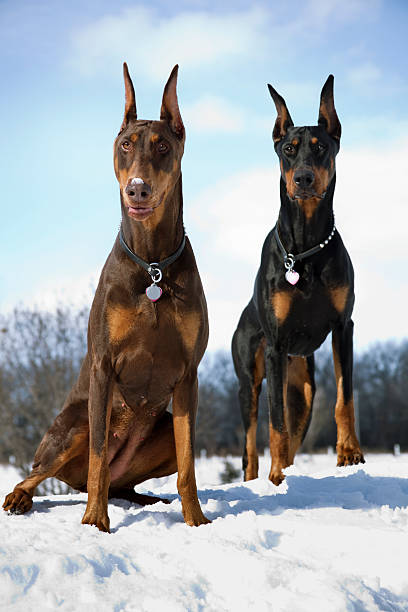
Dobermans are known for their sharp alertness, deep loyalty, and high need for activity, making them outstanding watchdogs and loving pets. Even as puppies, these dogs show a knack for learning and getting along with others.
Below is a guide to the key traits of the Doberman breed:
| Trait | Description | Considerations |
|---|---|---|
| Alertness | They quickly notice changes in their surroundings | Training helps manage their instinct to protect |
| Loyalty | They form strong bonds with their owners | They thrive on interaction and companionship |
| Energy Level | They have a lot of stamina and need to stay active | Regular exercise and mental challenges are vital |
| Coat | Their coats are short and sleek, usually with rust-colored spots | They need little grooming but might need a coat in cold weather |
| Protective Instinct | They naturally want to defend their home and family | Teaching them how to interact from a young age is key |
Dobermans have an easy-to-care-for coat, but their vibrant energy and protective nature require thoughtful training and plenty of playtime. When their talents are guided correctly, they shine as protective and affectionate family members.
Doberman Origin Story: Pet Parents

The Doberman Pinscher came into existence in the late 1800s, crafted by Louis Dobermann, who wanted a loyal and protective companion. This dog breed was carefully developed through crossbreeding various breeds to bring out traits ideal for a guard dog. The Doberman evolved from a local protector into a globally recognized breed, valued for its versatility, including roles in military contexts.
Breed Origins
The Doberman’s history began with the need for a dependable guard dog. Louis Dobermann, a tax collector, needed an alert and protective dog. His efforts led to the creating of a breed known for its intelligence and loyalty.
Primary Roles
Initially, Dobermans served as guard dogs and companions. Their intelligence and trainability made them suitable for various tasks. They soon became popular police dogs and were also used in war efforts, showcasing their adaptability in different environments.
Historically Significant Dobermans
Throughout history, several Dobermans have stood out for their service. They have been recognized for their bravery in wars and dedication as service dogs. These notable Dobermans have contributed to the breed’s esteemed reputation as a versatile and reliable working dog.
Breed Inception History
During the latter part of the 1800s, Louis Dobermann from Germany began developing the Doberman Pinscher breed. His work as a tax collector required a loyal and protective dog by his side. Louis Dobermann aimed to create a breed that embodied strength, loyalty, and intelligence. He meticulously selected and crossbred various German breeds, including the German Shepherd, Rottweiler, Weimaraner, and Greyhound, to craft the ideal dog.
After Louis Dobermann passed away, other breeders continued to refine the Doberman’s physical and behavioral traits. Their dedicated work led to the birth of the contemporary Doberman Pinscher. This breed was formally recognized by the American Kennel Club in 1908.
The history of the Doberman’s creation is a testament to the focused and systematic dog breeding process.
Original Function & Use
Reflecting on the rich history of the Doberman Pinscher, it’s clear that Louis Dobermann crafted this breed to create a powerful guard dog. Originating in Germany in the late 1800s, the Doberman was a mix of breeds like the Rottweiler, Weimaraner, Greyhound, and German Pinscher, which gave it a unique set of skills suited for guarding, tracking, and protection duties.
These abilities led to its use in the military, and the Doberman notably served with the US Marine Corps during World War II, showcasing its loyalty and intelligence in the line of duty.
Notable Historical Dobermans
Dobermans like Cappy and Kurt became legends for their brave actions in World War II, showing how fearless and loyal this breed can be. These dogs were so impressive in battle that the US Marine Corps included Dobermans in their military dog units.
A memorial stands today to remember their service and sacrifice.
Regarding dog shows, the Doberman breed has also shined, with Ch. Rancho Dobes Storm won multiple Westminster Best in Show awards. This highlights both the beauty and the ability of the breed.
The Doberman Pinscher Club honors these dogs, maintaining the breed’s esteemed reputation and setting the bar high for Dobermans that follow.
Doberman Body Dimensions
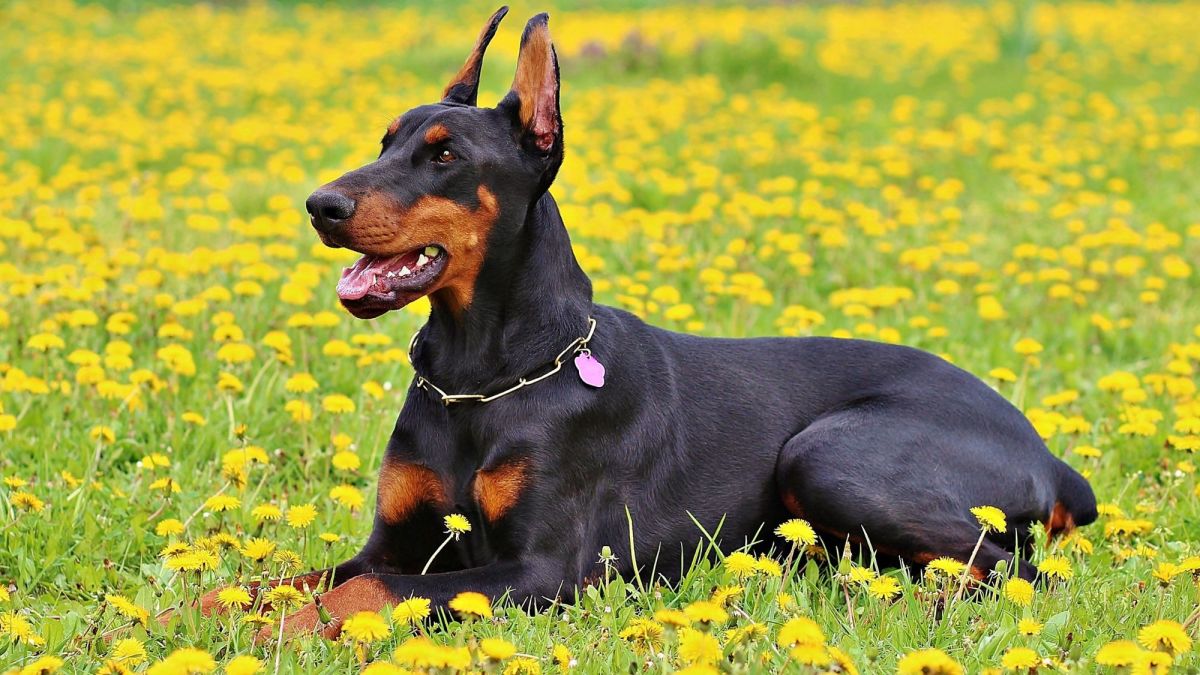
The Doberman Pinscher is known for its muscular physique, a trait essential for its historical role as a guard and working dog. When considering the size and build of this breed, there are a few critical aspects to note:
Height Range
Male Dobermans typically stand between 26 and 28 inches at the shoulder, while females are usually a bit shorter, ranging from 24 to 26 inches. This height difference is standard and reflects the breed’s size variation based on gender.
Weight Standards
Male Dobermans can weigh between 75 and 100 pounds, and females generally tip the scales at 60 to 90 pounds. These figures are guidelines to ensure the dogs are healthy and fit, which is vital given their active nature.
Proportionate Build
A well-built Doberman should exhibit a proportionate body, meaning its length and height are balanced, contributing to its agile and sturdy appearance. The breed’s muscular structure supports their energetic lifestyle and the tasks they were initially bred for.
Typical Height Range
Doberman Pinschers stand tall and muscular, with males usually between 26-28 inches at the shoulder, while females are a bit shorter at 24-26 inches. The American Kennel Club recognizes them and has a commanding presence that hints at their strength.
Male Dobermans often weigh between 75 and 100 pounds, and females range from 60 to 90 pounds, showcasing their solid frame. These dogs were bred for protection and work, so their size isn’t just for looks – it’s for performance.
It’s essential for those considering a Doberman to understand their size, as it affects their exercise needs and potential health issues, especially their joints and heart.
Dobermans are a breed that’s both impressive in stature and requires attentive care from their owners. Their size and weight are key factors to keep in mind for their overall well-being and to prevent health problems. These powerful dogs need plenty of activity to stay healthy and happy, so a future owner should be ready for an active lifestyle.
Weight Specifications
Maintaining a healthy weight is critical for Doberman Pinschers to stay in shape. Male Dobermans should weigh between 75 and 100 pounds, while females should be between 60 and 90 pounds. Keeping their weight in check helps prevent health issues.
For example, if a Doberman gets too heavy, they could develop joint problems like hip dysplasia, which can be painful and lead to arthritis. On the other hand, if they’re too thin, they might be more likely to get Dilated Cardiomyopathy (DCM), a heart condition common in the breed that impairs the heart’s function.
Since Dobermans have short coats, they don’t have much natural insulation. They must maintain a proper weight to regulate their body temperature and stay healthy.
Proportional Body Structure
Doberman Pinschers are the epitome of balance and athleticism, standing tall at 26-28 inches for males and slightly shorter at 24-26 inches for females. They weigh a sturdy 75-100 pounds for males and a somewhat lighter 60-90 pounds for females, showcasing their muscular and streamlined frames.
To keep a Doberman in top form, closely monitoring their height and weight is crucial. This vigilance helps prevent health issues like congestive heart failure and Willebrands disease, which can worsen if they’re not the correct weight.
Feeding them high-quality food and engaging them in regular exercise is vital to maintaining their impressive physique. It’s not just about looks; a well-proportioned body ensures that Dobermans stay agile and robust. This is vital for their overall well-being, so owners should pay close attention to their Doberman’s diet and activity levels.
Breed Size Comparison
When we look at the size of different dog breeds, it’s clear that Doberman Pinschers stand out in their group. They are often compared to German Shepherds because they share similar work roles, like assisting in law enforcement.
Male Dobermans typically reach 26-28 inches tall and have a weight range of 75-100 pounds, whereas the females are a bit smaller, around 24-26 inches in height and 60-90 pounds. On the other hand, male German Shepherds stand at about 24-26 inches and weigh 65-90 pounds, while their female counterparts are usually 22-24 inches tall with a weight of 50-70 pounds.
This highlights the Doberman’s robust build and significant presence within the Working Group of Dogs.
Standard Physical Features
Doberman Pinschers typically stand between 26 and 28 inches tall at the shoulder for males and 24 and 26 inches for females. This size classifies them as a medium-to-large dog within the Working Group. Male Dobermans generally weigh between 75 and 100 pounds, whereas females tend to be a bit lighter, ranging from 60 to 90 pounds. These dogs have an average lifespan of about 10 to 12 years.
These solid and athletic dogs are known for their sleek, short coats. Dobermans’ most recognized coat color is Black and Tan, though they can also be red, blue, or fawn with rust-colored markings. Traditionally, Dobermans have had their ears cropped and their tails docked, giving them a distinctive appearance. However, it’s worth noting that these practices are falling out of favor due to changing views on animal welfare.
Doberman Pinscher Temperament Traits
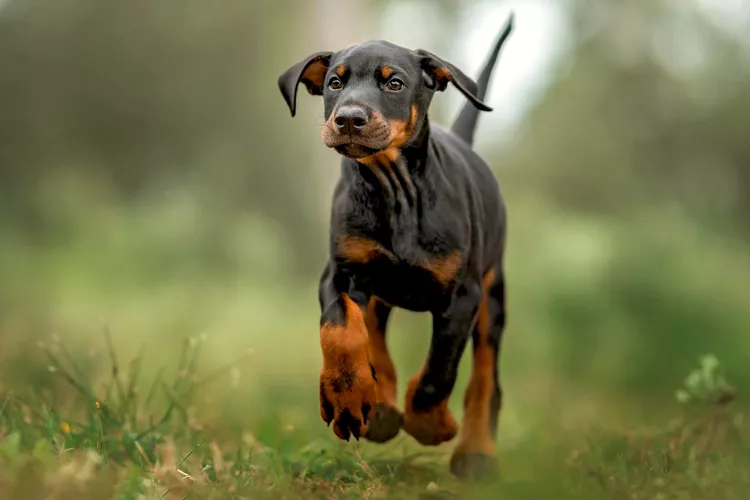
Doberman Pinschers are known for their instinct to protect, so it’s crucial to socialize them properly. This helps prevent their protective nature from turning into aggressive behavior towards strangers.
They’re also brilliant dogs, which means they pick up on training quickly. They thrive on challenging tasks and need lots of exercise and mental stimulation. Without it, they can become bored and might start chewing or digging.
Doberman owners must understand these traits to keep their dogs happy and well-behaved. Regular training sessions and plenty of play and exercise will help maintain a well-adjusted Doberman.
This breed’s intelligence and energy make them great companions, but they need an owner who can commit to their care.
Protective Instincts
Doberman Pinschers are known for their strong protective instincts and deep bonds with their owners, making them top choices for family protection. These dogs are naturally alert and have a keen sense of judgment, which makes them ideal for guarding. They are quick learners and respond well to training that uses positive rewards. This kind of training helps Dobermans to act appropriately when they sense danger.
Early socialization is crucial in preventing excessive aggression in Dobermans and helps them get along with others. In a caring home, a Doberman’s instinct to protect becomes a reliable defense, reflecting the admirable traits of the breed.
Intelligence Level
Doberman Pinschers are brilliant dogs with a natural ability to learn quickly and handle complicated tasks. Their sharp minds shine through when they pick up new instructions rapidly, making them excellent candidates for obedience training.
To tap into their intellect, it’s crucial to start training and socializing them early on. This approach not only boosts their learning but also shapes a well-adjusted character.
Using consistent, positive methods in training is critical to keeping Dobermans engaged and willing to learn. They thrive on mental challenges and need regular brain games to stay sharp. This helps keep their minds active and prevents unwanted behaviors from cropping up.
Known for their keen vigilance, Dobermans make for outstanding guard dogs, always on the alert and ready to evaluate potential threats in their surroundings.
Energy and Drive
Doberman Pinschers are known for their high energy and motivation, making them ideal for activities that require stamina and enthusiasm. Their strong work ethic and lively spirit make them excel in tasks that engage them physically and mentally.
To keep a Doberman healthy and happy, daily exercise and stimulation is essential. Activities like long walks, agility training, and obedience sessions are great ways to occupy them.
Ensuring they get enough exercise helps prevent boredom and unwanted behaviors, keeping your Doberman a content and well-behaved pet.
Aggression Management
When training Doberman Pinschers, focusing on their protective instincts and potential for aggression is vital. This ensures safety for both the dog and the people around it. Dobermans have a strong prey drive and are always on alert, so training should be based on positive reinforcements to curb any unnecessary aggressive behavior.
Introducing them to different people and animals early on can help them behave better around strangers. Regular training classes provide an excellent way for your Doberman to learn and socialize safely, which can help prevent aggressive outbursts.
Each Doberman has a personality, so adjusting your training to fit their needs is critical for effectively managing aggression.
For the safety and happiness of Dobermans and their owners, managing the breed’s natural protectiveness and potential for aggression is crucial. Positive reinforcement is the best training method because it helps control aggressive reactions without causing fear or resentment in the dog.
Socializing your Doberman early in life is essential to teach them how to interact calmly with new people and animals. Training classes are also beneficial, providing mental stimulation and helping to prevent aggression.
It’s important to remember that every Doberman is different, so aggression management techniques should be customized to each dog’s personality.
Training Responsiveness
Doberman Pinschers are highly skilled when it comes to learning and obeying commands. Their past work as service dogs has equipped them with a temperament perfect for training. These dogs are known for their obedience, a trait in their genes. They are bright, alert, and incredibly loyal, all qualities that make them excel in training.
Dobermans are often at the top of the list when comparing the trainability of different dog breeds. They have a natural ability to pick up complex tasks quickly. Plus, they want to make their owners happy. Research into dog behavior shows that Dobermans are great at taking on training programs. This makes them stand out in any role that needs discipline and a quick reaction to commands.
The proper training can bring out the best in a Doberman, turning them into exceptional working dogs.
Doberman Pinscher Health Concerns
Doberman Pinschers face several inherited health issues that demand attention from breeders, vets, and their families. Knowing about these diseases is vital for keeping Dobermans healthy and can lead to better outcomes if caught early.
Von Willebrand Disease is a common inherited bleeding disorder in Dobermans. It affects the blood’s ability to clot, leading to severe complications during surgeries or injuries. Testing for this disease is a must for responsible breeding practices.
Heart health is a big concern for Dobermans because they are prone to Dilated Cardiomyopathy (DCM). This condition weakens the heart muscle, leading to heart failure. Regular check-ups with a vet can catch heart issues early, which is critical for managing the disease.
Another condition that Dobermans are genetically inclined to develop is Hip Dysplasia. This disease can severely restrict a dog’s movement and decrease their quality of life. Early detection and proper care, including weight management and appropriate exercise, can help manage hip dysplasia.
Doberman owners must know these health concerns and work with their vet to keep their dogs as healthy as possible. Regular health screenings and responsible breeding can help reduce the risk of these genetic conditions.
Common Health Issues
Doberman Pinschers are admired for their sharp intelligence and steadfast loyalty, but they also face particular health challenges due to their genetics. Owners should be exceptionally watchful for issues like dilated cardiomyopathy, a heart condition where the heart becomes enlarged and struggles to pump blood efficiently. This often leads to congestive heart failure.
Another concern is Von Willebrand’s Disease, an inherited disorder that impacts blood clotting due to a lack of von Willebrand factor.
Hip dysplasia is also a common concern in Dobermans; it’s a condition where the hip joints develop abnormally, causing discomfort and hindering movement.
Regular check-ups with a vet are crucial to help these dogs lead healthier lives. Responsible breeding practices can reduce the risk of these diseases and improve the overall well-being of the breed.
Genetic Disorder Risks
Regular vet visits are essential for Doberman Pinschers to stay healthy. It’s just as vital to know about their risk for genetic issues. Conditions like Von Willebrand Disease, which affects blood clotting, Hip Dysplasia, a problem with the hip joint, and Dilated Cardiomyopathy, a severe heart issue, can all impact Dobermans.
To ensure a Doberman puppy has the best chance at a healthy life, getting health screenings and genetic tests before you get one is essential. Choosing breeders who prioritize health can also help reduce these risks.
Understanding these conditions is the first step in preventing them and keeping your dog healthy. Working with vets and responsible breeders can help create plans to lower the chances of these diseases in Dobermans.
Preventative Health Measures
To help Doberman Pinschers stay healthy and reduce the risk of inherited disorders like Von Willebrand Disease, Dilated Cardiomyopathy, and Hip Dysplasia, dog owners should take them for regular health check-ups and consider getting genetic tests. These steps are essential for catching any issues early and managing them effectively.
A balanced diet is also vital to keep Dobermans in good shape and possibly lessen the impact of genetic problems.
Encouraging Dobermans to stay active through physical and mental exercises helps keep them sharp and may prevent breed-specific health issues.
It’s also essential to give them a secure living space and start early socialization and training to support their overall well-being.
Caring for a Doberman: Grooming Essentials
Grooming a Doberman Pinscher is essential for keeping up with their iconic look and overall health. Every step of their grooming routine plays a role in supporting their skin and coat and warding off potential health issues. Sticking to a consistent grooming schedule is vital to keep your Doberman in tip-top shape.
Routine Coat Maintenance: Brushing your Doberman regularly is critical to controlling shedding and helping their skin oils circulate correctly.
Nail Care: Keeping your dog’s nails short is essential to avoid affecting their walk and putting pressure on their foot joints.
Ear Health: Regularly checking and cleaning your Doberman’s ears helps prevent ear infections and maintain hearing.
Use quality grooming tools and products, and consult your vet for any specific concerns or advice on maintaining your Doberman’s health through proper grooming.
Coat Care Routine
Regular brushing is essential to keep a Doberman’s coat shiny and minimize shedding. Use the right tools for brushing to keep the skin safe and the coat shiny. A Doberman Pinscher’s grooming routine includes maintaining its distinct short and sleek coat, which may involve tail docking and ear cropping for those following traditional standards.
Dobermans should have a bath every two months or when needed, using a mild shampoo made for dogs to keep their coat’s natural oils. It’s essential to routinely clean a Doberman’s ears, significantly if they have cropped ears, which can be more prone to infections due to less airflow.
Keeping their nails trimmed every two months helps avoid problems from nails getting too long. Good dental care is also critical to prevent gum disease.
Nail Trimming Importance
Trimming a Doberman’s nails regularly is crucial for their comfort and health. Allowing nails to grow too long can cause pain and even change how Dobermans walk, potentially leading to joint problems. Keeping nails short prevents injuries and makes moving around easier for these active dogs.
Owners should prioritize nail care to prevent painful conditions like ingrown nails and infections. Proper nail maintenance supports a Doberman’s active lifestyle. When trimming nails, it’s essential to avoid hurting the dog and maintain their ability to move smoothly.
Ear Cleaning Tips
Caring for a Doberman’s nails is as crucial as keeping their ears clean. When cleaning their ears, use a vet-recommended solution and gently clean the inside of the ear flap without going into the ear canal. Look for redness, swelling, or strange smells indicating an infection. Cleaning their ears too much can mess up the natural balance of bacteria, so it’s best to do it just enough.
For Dobermans with cropped ears, special care is needed to prevent dirt and moisture buildup. After cleaning, consistently reward your dog for helping build a positive connection with grooming, making future sessions easier.
It’s essential to maintain the health of your Doberman’s ears. Using a cleaning solution from your vet, carefully wipe the ear flap and avoid inserting anything into the ear canal. Look for any redness, swelling, or odor, as these could be signs of an ear infection. Over-cleaning can disrupt the ear’s natural bacteria, so moderation is key.
Dobermans with clipped ears need extra attention to keep debris and moisture out. After each ear-cleaning session, give your Doberman plenty of praise and treats. This helps them associate grooming with good experiences, making them more cooperative in the future.
Bathing Frequency Recommendations
Dobermans should be bathed every six to eight weeks for healthy skin and a clean coat. The exact schedule might change based on how active the dog is and their environment. Washing your Doberman helps remove dirt, debris, and allergens in their fur. This not only keeps them looking sharp but also supports their skin health.
It’s essential to use a gentle dog shampoo made for Dobermans to avoid irritating their skin and maintain the oils that protect them. Rinse thoroughly to remove any left shampoo because it could irritate.
Regularly checking and cleaning your Doberman’s ears is also a good idea to prevent wax buildup and ear infections.
Skin Health Maintenance
Sticking to a regular grooming schedule would be best to keep your Doberman’s coats shiny and their skin healthy. This includes frequent brushing, which helps reduce shedding and maintains the skin’s condition. Paying close attention to their ears is especially important to prevent ear infections if they have cropped ears.
It’s vital to watch out for skin problems like dryness, redness, or flaking, and contact a vet if you notice anything unusual.
High-quality grooming products are vital to keeping your dog’s skin balanced and clean. It’s not just about their physical health—a Doberman’s overall well-being benefits from mental and physical activity. These activities keep them engaged and can positively affect their skin health.
Doberman Diet Requirements
Maintaining the health and vitality of Doberman Pinschers requires a careful approach to their diet. Understanding the breed’s nutritional needs is critical to keeping them in top condition and avoiding any nutritional deficits or overfeeding.
Nutritional Requirements
Dobermans need a balanced protein-rich diet to support their muscular build and high energy levels. It’s essential to include animal-based proteins, fats, and a mix of fruits and vegetables for vital vitamins and minerals. Always check with your vet to ensure their diet meets their health needs.
Feeding Schedule
Consistency is vital when feeding your Doberman. Adult Dobermans typically do well with two meals a day. This routine helps prevent bloating, a severe health risk for this breed. Puppies, however, may require more frequent feedings to support their rapid growth.
Diverse Diet Tips
Varying your Doberman’s diet can help cover all nutritional bases and prevent boredom with their meals. Include different protein sources and rotate the types of vegetables and fruits you offer. Always introduce new foods slowly and monitor for any adverse reactions.
These guidelines are designed to keep your Doberman healthy and satisfied. A well-planned diet is a cornerstone of their overall well-being. Consider any dietary changes, and consult your vet for tailored advice.
Nutritional Needs
Doberman Pinschers are active dogs and need a diet rich in proteins and fats to keep their muscles strong and energy levels high. The right food helps them stay physically and mentally sharp and should be packed with nutrients.
Puppies of this breed benefit from a specific diet that supports healthy growth and organ function. To prevent health issues like Gastric Dilatation-Volvulus (GDV), it’s best to split their meals into two servings per day. Consulting a vet can help tailor their diet to maintain a healthy weight and avoid the risks of obesity.
Adding supplements like omega-3 fatty acids can support their overall health, and nutrients that aid joint health are crucial for their bone structure.
Feeding Frequency
Feeding your Doberman Pinscher twice daily is vital to keeping them healthy and energetic. This routine helps prevent severe conditions like bloat, also known as gastric dilatation-volvulus (GDV). A vet should tailor your dog’s diet to their unique needs, considering their metabolism, size, and activity.
Regular meals fuel their active lifestyle and help with training by creating a reliable schedule.
Providing a diet rich in quality proteins and omega-3 fatty acids is vital. These nutrients are essential for maintaining strong muscles and good health in your Doberman.
Diet Variation Tips
A nutritious diet high in protein is essential for a Doberman’s health, especially given their muscular build and active lifestyle. They thrive on a diet that includes a perfect mix of macronutrients, such as essential fats, notably omega-3 fatty acids, which keep their skin and coat in top condition.
To keep Dobermans in peak shape, they should vary their protein sources, rotating between options like chicken, beef, and fish, to supply various nutrients and prevent potential food allergies.
Portion control is also crucial, with meal sizes tailored to the dog’s energy expenditure and metabolic needs to prevent weight gain. Specialized nutrition is necessary to support the growth of Doberman puppies, so working with a vet to create an appropriate diet plan is wise. This ensures the puppies get the proper nutrients for their specific breed requirements.
